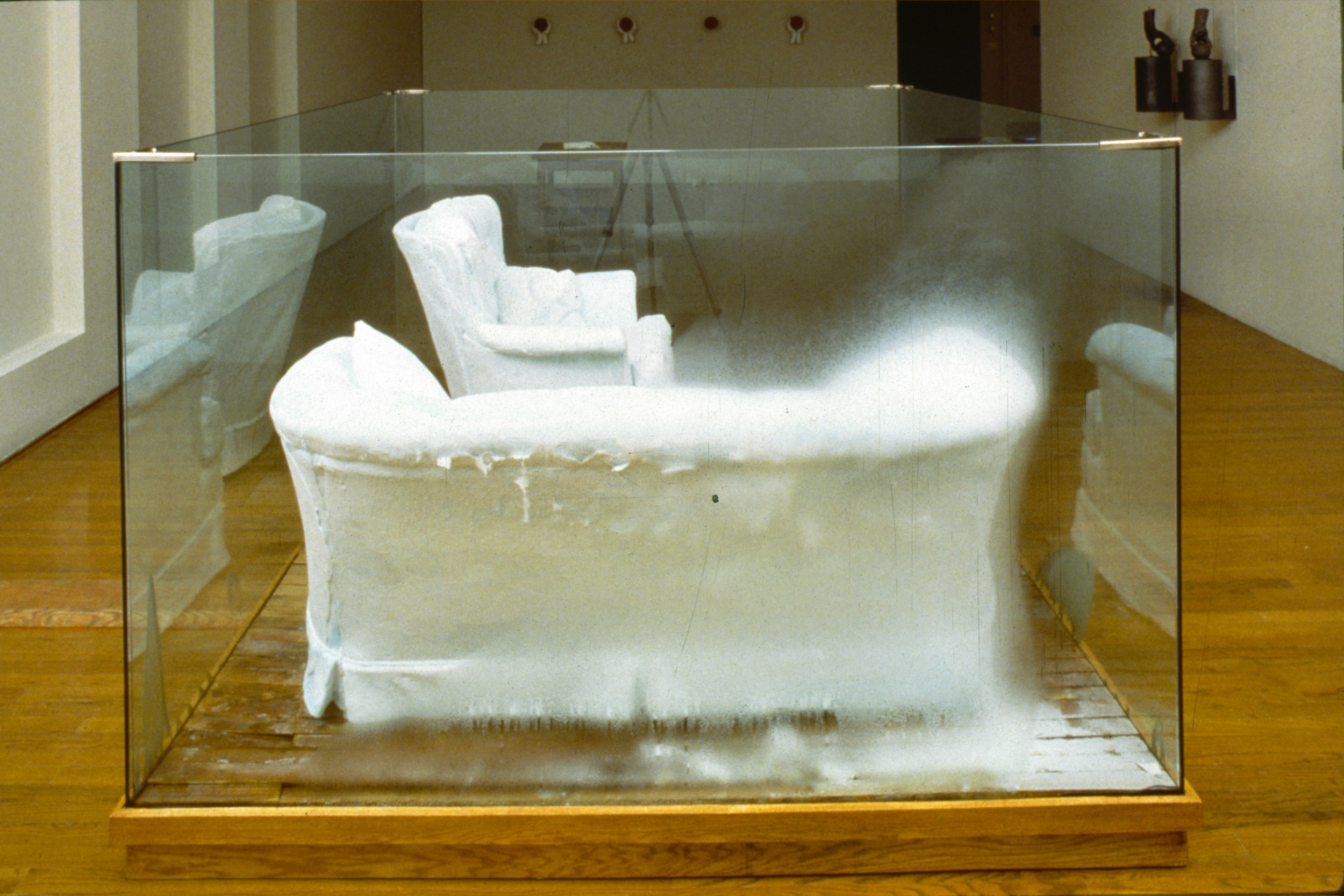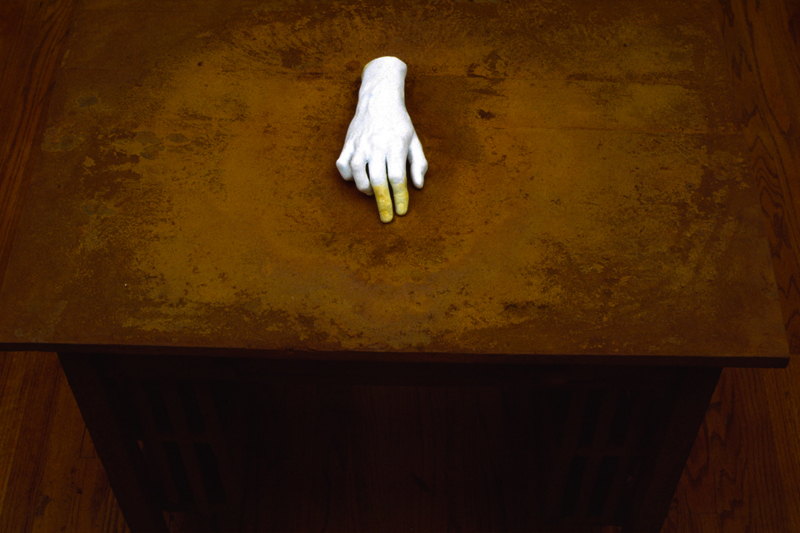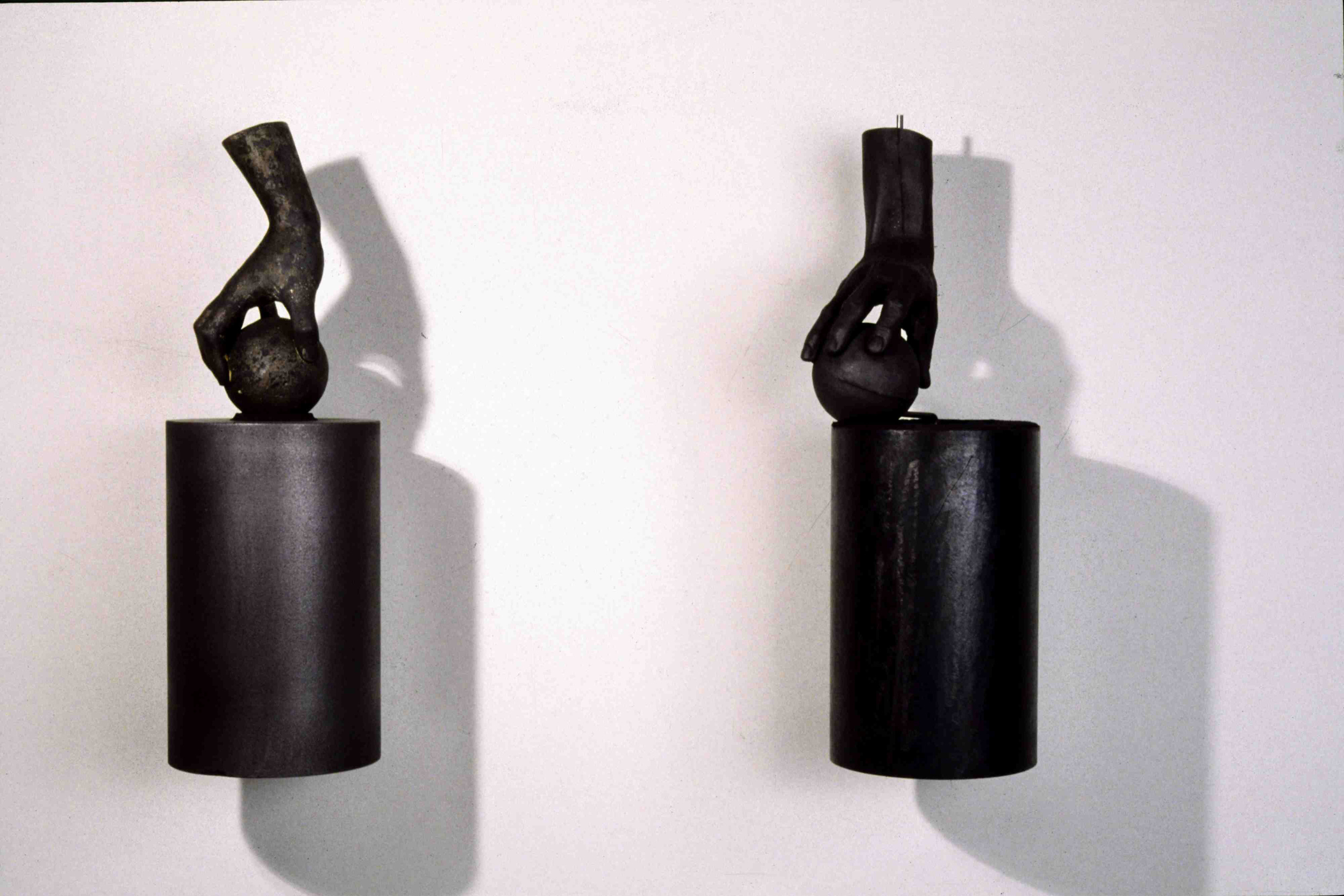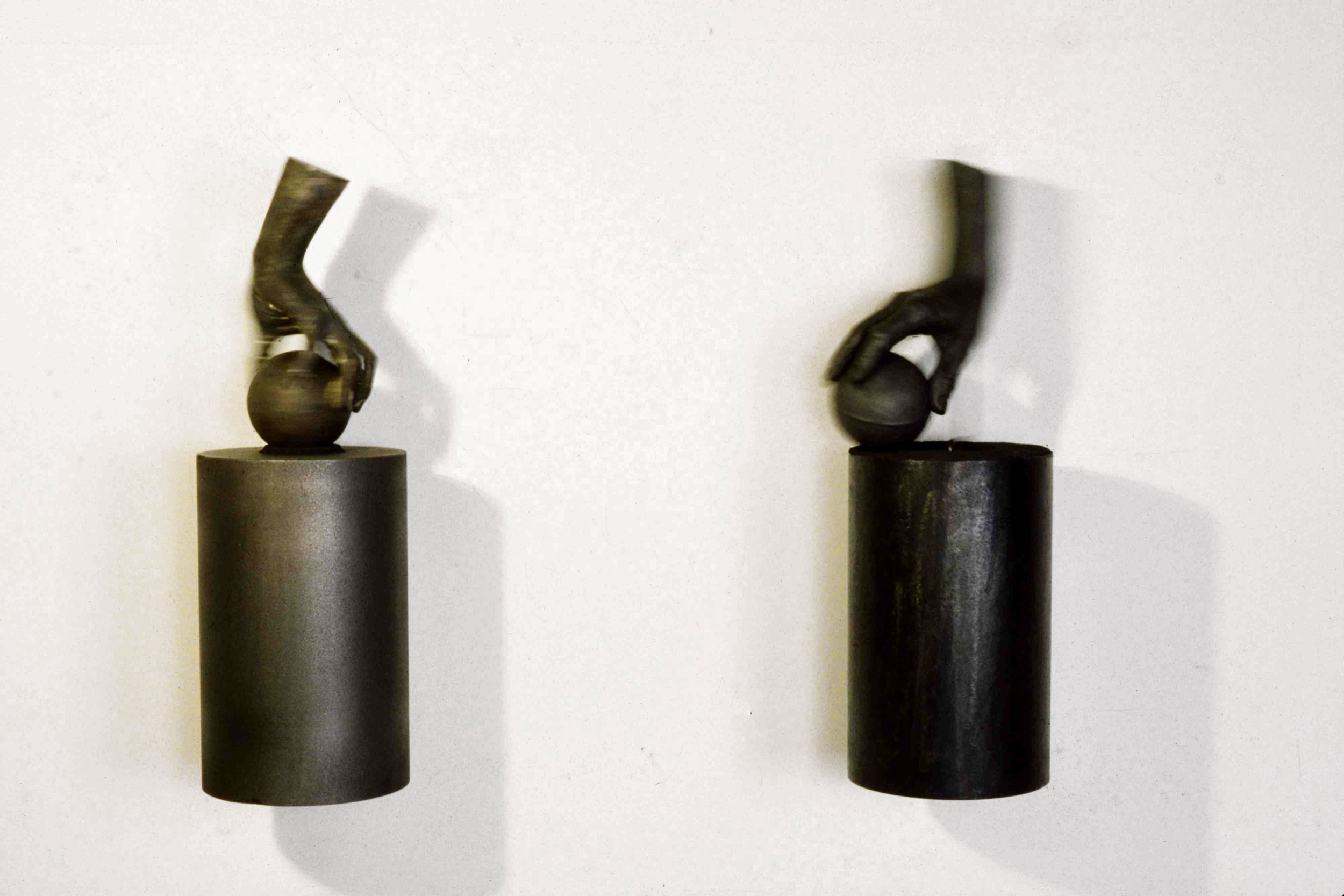



























Akron Art Museum, 1993
Essay by Barbara Tannenbaum, Chief Curator, Akron Art Museum, 1993
“The sculptures of Todd Slaughter in this exhibition will destroy themselves
while they are on display. Their demise will occur not because of a sudden
cataclysm but rather through a gradual, relentless process of disintegration.
Each work sets two elements in opposition, one standing for the human body and
the other representing the external forces that form our environment. These may
be natural, societal or psychological ones; they are represented by abstract
geometric forms such as spheres or cylinders that defy specific associations.
Two types of relationships are possible between the two elements: one may prove
to be the stronger and enduree, but more frequently they destroy each
other."
Leaving a Mark, One R.P.M., march 1992, shows evidence of both types of relationships. The wall-mounted sculpture consists of two units, each a hand grasping a sphere and poised atop a cylinder. The image of the hand holding a sphere in its fingertips, center to much of Slaughter’s work over the past two years, interjects the possibility of human control over external forces. Taken from a book analyzing the hand by John Napier, it represents ”the precision grip,” which allows the hand to control things and symbolizes the muscular co-ordination that has enabled humans to develop and use tools.
Although at first the two units of Leaving a Mark appear identical, time and motion reveal that in one, the hand and sphere are cast from graphite that wears down as it rotates against a steel cylinder. In its twin, the materials are reversed and the sphere draws ever deeper furrows in a graphite cylinder. In each unit, one element triumphs; taken together, both humans and the forces they battle are worn down. The precision grip is also featured in Slipping Hands, One R.P. M., February 1993, which consists of four sets of hands cast from salt holding cylinders of cast red pepper and paprika. As the cylinders turn against the irregularly shaped fingertips, both erode. Desk and Table, April 1993, a cast iron desk, further distills the essence of this interrelationship. The salt erodes the iron while the iron rusts the salt in slow mutual destruction.
Slaughter injects complexity (and hope) into his metaphors by choosing materials – salt and pepper – that have preservative as well as corrosive properties. In fact, the graphite, salt, and pepper do not perish but instead undergo a transformation from solid to a powder, ending up heaped on the floor below the sculpture. Finally, the works have a subtle but definite sensual presence, engaging vision, hearing and smell to suggest that the passage from creation to destruction can be affirming and, indeed, pleasurable.
Slaughter’s work has long mediated on fragility and mortality through abstracted forms. Here, he has more directly expressed these concerns in purposely ephemeral artworks. These issues may have gained added urgency because of recent events in his personal life, including the artist’s fiftieth birthday and recent death of a parent. The truths they suggest, however, are both universal and timeless.”
Akron Art Museum, 1993
Essay by Barbara Tannenbaum, Chief Curator, Akron Art Museum, 1993
“The sculptures of Todd Slaughter in this exhibition will destroy themselves
while they are on display. Their demise will occur not because of a sudden
cataclysm but rather through a gradual, relentless process of disintegration.
Each work sets two elements in opposition, one standing for the human body and
the other representing the external forces that form our environment. These may
be natural, societal or psychological ones; they are represented by abstract
geometric forms such as spheres or cylinders that defy specific associations.
Two types of relationships are possible between the two elements: one may prove
to be the stronger and enduree, but more frequently they destroy each
other."
Leaving a Mark, One R.P.M., march 1992, shows evidence of both types of relationships. The wall-mounted sculpture consists of two units, each a hand grasping a sphere and poised atop a cylinder. The image of the hand holding a sphere in its fingertips, center to much of Slaughter’s work over the past two years, interjects the possibility of human control over external forces. Taken from a book analyzing the hand by John Napier, it represents ”the precision grip,” which allows the hand to control things and symbolizes the muscular co-ordination that has enabled humans to develop and use tools.
Although at first the two units of Leaving a Mark appear identical, time and motion reveal that in one, the hand and sphere are cast from graphite that wears down as it rotates against a steel cylinder. In its twin, the materials are reversed and the sphere draws ever deeper furrows in a graphite cylinder. In each unit, one element triumphs; taken together, both humans and the forces they battle are worn down. The precision grip is also featured in Slipping Hands, One R.P. M., February 1993, which consists of four sets of hands cast from salt holding cylinders of cast red pepper and paprika. As the cylinders turn against the irregularly shaped fingertips, both erode. Desk and Table, April 1993, a cast iron desk, further distills the essence of this interrelationship. The salt erodes the iron while the iron rusts the salt in slow mutual destruction.
Slaughter injects complexity (and hope) into his metaphors by choosing materials – salt and pepper – that have preservative as well as corrosive properties. In fact, the graphite, salt, and pepper do not perish but instead undergo a transformation from solid to a powder, ending up heaped on the floor below the sculpture. Finally, the works have a subtle but definite sensual presence, engaging vision, hearing and smell to suggest that the passage from creation to destruction can be affirming and, indeed, pleasurable.
Slaughter’s work has long mediated on fragility and mortality through abstracted forms. Here, he has more directly expressed these concerns in purposely ephemeral artworks. These issues may have gained added urgency because of recent events in his personal life, including the artist’s fiftieth birthday and recent death of a parent. The truths they suggest, however, are both universal and timeless.”
Comfort Zone
Desk and Hand
Cupped Hands
Cupped Hands (In Motion)
Leaving a Mark
Leaving a Mark (In Motion)
Falling Hand
Grinding Fist
Grinding Knuckles
Grinding Knuckles (In Motion)
Hand, Ball, & Stick
Slipping Hands
Hand, Stick, Sphere 1
Hand, Stick, Sphere 2
Revolution Evolution
Charcoal Archive
Sulfur Archive
Paprika Archive
Salt Archive